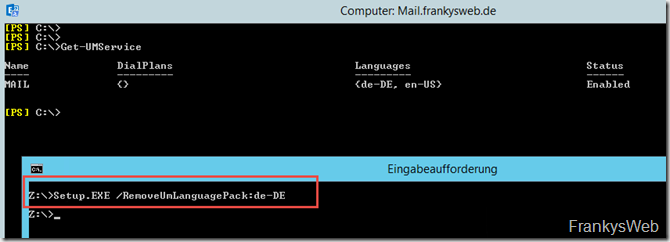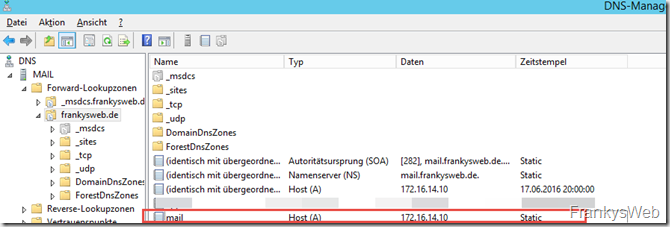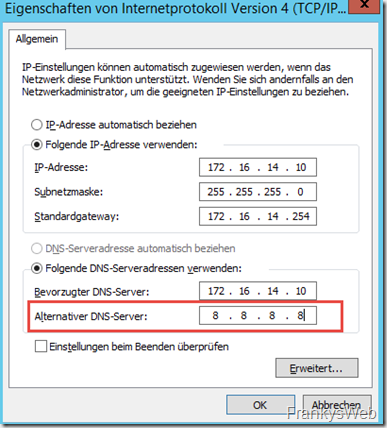Testing, testing, testing and checking requirements
As Exchange is a central and important system in many companies, it is advisable to test new updates in a test environment. The test environment should correspond as closely as possible to the productive environment. Of course, other applications/processes/services that are dependent on Exchange must also be tested as far as possible. Everyone must decide for themselves how far they want to or can go in the tests.
The compatibility of all dependent software (e.g. backup software, virus scanner, archive solution, etc.) must also be checked, especially in the case of major updates or many changes in the release notes.
Also very important: Read the release notes and check whether there are changes to important functions that are important for the company.
Download updates
Exchange 2013/2016 updates are quite large, as they are always the complete installation sources. This has the advantage that the updates can also be used for reinstallation without having to download the RTM version, service pack or update rollup first.
On the other hand, you don't want to waste unnecessary time during the maintenance window waiting for the download. The CU2 for Exchange 2016 has just under 7 GB.
Create backup
Before installing the updates, a current backup should be created, not only of the Exchange servers and databases, but also of the domain controllers and the Active Directory. At this point, you can also briefly consider whether the restore has already been tested and whether it is known what to do in the event of a restore.
Preparation for the update
The preparation of Exchange 2013/2016 for the import of updates depends on the environment.
In an Exchange 2013 organization that contains dedicated Client Access and Mailbox Servers, all Mailbox Servers should be updated first, followed by the Client Access Servers.
In an Exchange 2016 organization, it is best to start with the server that is currently least busy.
If there are upstream load balancers for the client access servers, the server to be updated should be removed from the load balancing network. The procedure for this varies depending on the load balancer used.
Before the update, the event log should also be checked for entries that do not belong there. Errors in the event log that occur before the update process should be corrected or at least noted. Otherwise, in the event of a problem, you may end up going through "unimportant events" that have been there for years...
Before starting the update procedure, you should also take a look at the databases: which databases are mounted and is the index OK?
Start Exchange Maintenance Mode
From here it gets serious. Exchange 2013 / 2016
Set-MailboxServer "SERVERNAME" -DatabaseCopyActivationDisabledAndMoveNow $True Set-ServerComponentState -Identity "SERVERNAME" -Component HubTransport -State Draining -Requester Maintenance Suspend-ClusterNode -Name "SERVERNAME" Set-MailboxServer -Identity "SERVERNAME" -DatabaseCopyAutoActivationPolicy Blocked Set-ServerComponentState "SERVERNAME" -Component ServerWideOffline -State InActive -Requester Maintenance
Install updates
The server is offline. For larger environments with several locations and possibly distributed Exchange servers, the schema should first be updated manually when the update performs a schema update. The Active Directory schema can be updated manually with the following command:
setup.exe /PrepareSchema /IAcceptExchangeServerLicenseTerms setup.exe /PrepareAD /IAcceptExchangeServerLicenseTerms setup.exe /PrepareDomain /IAcceptExchangeServerLicenseTerms
After updating the schema, the replication of the domain controllers must be awaited.
Note: The schema update is also carried out by the update process. If there is only one Exchange server and only one small Active Directory with one location, the schema update can also be updated directly via the Exchange update process. The Exchange does not have to be in maintenance mode for the schema update either, so the schema update can also be carried out in the "Preparing for the update" section.
The updates can now be installed on the first server.
Exit Exchange Maintenance Mode
Maintenance mode must be ended after installing the updates.
Important: Don't forget to exit maintenance mode! Otherwise all databases will be offline on the last server at the latest
Set-MailboxServer -Identity "SERVERNAME" -DatabaseCopyAutoActivationPolicy Unrestricted Resume-ClusterNode -Name "SERVERNAME" Set-ServerComponentState -Identity "SERVERNAME" -Component HubTransport -State Active -Requester Maintenance Set-MailboxServer -Identity "SERVERNAME" -DatabaseCopyActivationDisabledAndMoveNow $False Set-ServerComponentState "SERVERNAME" -Component ServerWideOffline -State Active -Requester Maintenance
The server is now back in normal operation. The event log should now also be checked for entries. It is also advisable to take another look at the databases and their index.
If the server was previously removed from a load balancing network, it can be resumed.
Update additional servers / update servers in parallel
Updates on Exchange servers can be installed in parallel on several servers. However, with Exchange 2013 it is important to ensure that the mailbox servers are only updated when the Exchange roles are running on separate servers. If the update includes a schema update, the schema must be updated first and then the replication must be waited for, only then should further servers be updated. Depending on the environment, attention must be paid to the databases and mailbox servers. With 10 servers, it is certainly not advisable to update 9 at the same time and concentrate the entire load on one Exchange server.
Possible errors during the update
Errors can of course also occur during the update process. Here is a small selection of common problems and their solutions:
Error:
Setup can't continue with the upgrade because the powershell (15352) has open files. Close the process, and then restart Setup.
For more information, visit: http://technet.microsoft.com/library(EXCHG.150)/ms.exch.setupreadiness.ProcessNeedsToBeClosedOnUpgrade.aspxError:
All Unified Messaging language packs other than US English (en-US) must be uninstalled before you can upgrade the Mailbox server role. Detected language packs: de-DE"
For more information, visit: http://technet.microsoft.com/library(EXCHG.150)/ms.exch.setupreadiness.AdditionalUMLangPackExists.aspxWarning:
Setup can't verify that the 'Host' (A) record for this computer exists within the DNS database on server 172.16.14.10.
For more information, visit: http://technet.microsoft.com/library(EXCHG.150)/ms.exch.setupreadiness.HostRecordMissing.aspx
The first error can be rectified quickly, as all relevant information is already mentioned here. A PowerShell process with the ID 15352 is still running and is interfering with the update. The process is therefore terminated:
Stop-Process -Id "Process ID from error message"
The second error is a bit trickier. Exchange Setup expects all UM language packs except en-US to be uninstalled. In this case, the language pack de-DE interferes. All language packs can be displayed with the following command:
Get-UMService
However, the ISO or setup of the currently installed Exchange version is required for uninstallation. If the Exchange server is at patch level CU1, as in this case, the installation sources of CU1 are required to uninstall the language pack. It is therefore advisable to keep the corresponding CUs. In my case, I need the CU1 to uninstall the language pack. The uninstallation can then be initiated with the following command:
setup.exe /RemoveUMLanguagePack:Language pack
The last entry is a warning. The setup cannot determine whether there is a HOST-A entry for this server on the DNS server. You should therefore check here whether the DNS server has a corresponding entry:
The screenshot above shows my test environment, the entry exists, Exchange is installed on a domain controller in this case, so I can skip the warning. However, there are problems if an alternative DNS server is stored in the DNS configuration of the Exchange server that is not a domain controller, for example a router or public DNS server:
This entry should be removed beforehand and should not be set again later.










Der IAcceptEULA Parameter hat sich Aufgrund der EM-Einführung mit Exchange 2016 CU22 (und vermutlich dem entsprechenden CU für 2013 und 2019) geändert.
Bis CU22: /IAcceptExchangeServerLicenseTerms
Ab CU22: /IAcceptExchangeServerLicenseTerms_DiagnosticDataOFF
Hallo,
ist der Maintenance Mode auch erforderlich, wenn es nur einen DC und einen Exchange Server gibt ?
Hallo,
das interessiert mich auch. Meist liest man vom Maintenance Mode nur im Zusammenhang mit Exchange DAG. Aber wie sieht es bei einem standalone Exchange Server aus?
Grüße
Mike
Servus,
hab einen kleinen Server 2012R2 mit Exchange 2013 CU22 laufen und möchte CU23 einspielen, allerdings ist das Setup der Meinung das es kein Exchange auf dem Server gibt.
Stehe grad völlig auf dem Schlauch, im Hintergrund läuft das Ding allerdings einwandfrei.
Fehler:
Die Postfachserverrolle ist auf diesem Computer nicht installiert.
[….]
Setup bereitet die Organisation mithilfe von ‚Setup /PrepareAD‘ auf Exchange 2013 vor. In dieser Topologie wurden keine Exchange 2010-Serverrollen erkannt. Nach diesem Vorgang können Sie keine Exchange 2010-Server mehr installieren.
gruß Benny
Prima, so etwas hatte ich gesucht. Teste es mal am Samstag.
Gruß Michael
Hallo,
ich hab einen neuen Kunden übernommen mit einem Exchange 13 Version 15.0 (Build 847.32). Wie kann
ich den am besten updaten. Ich kann ja schlecht einfach das neuste CU installieren, oder? Zumindest
hätte ich da ein ungutes Gefühl. Für die älteren CUs gibt es ja kein Download mehr.
Danke.
MFG M.Keßler
Hallo Michael,
siehe hier:
https://www.frankysweb.de/exchange-2013-stolperstein-beim-update-einer-alten-version-auf-das-aktuelle-cu/Gruß,
Frank